Global Distribution and Density of Constructed Impervious Surfaces
Abstract
:1. Introduction
2. Methods
2.1 Nighttime Lights
- Center half of orbital swath (best geolocation and sharpest features).
- No sunlight present.
- No moonlight present.
- No solar glare contamination.
- Cloud-free (based on thermal detection of clouds).
- No contamination from auroral emissions.
2.2 LandScan 2004
2.3 ISA Estimation Model
2.4 Global ISA Grid
3. Results and Discussion
4. Conclusion
Acknowledgments
References
- Schueler, T.R. The importance of imperviousness. Watershed Protection Techniques 1994, 1(3), 100–111. [Google Scholar]
- Changnon, S.A. Inadvertent weather modification in urban areas: Lessons for global climate change. Bulletin of the American Meteorological Society 1992, 73, 619–627. [Google Scholar]
- Milesi, C.; Elvidge, C.D.; Nemani, R.R.; Running, S.W. Assessing the impact of urban land developlment on net primary productivity in the Southeastern United States. Remote Sensing of Environment 2003, 86, 401–410. [Google Scholar]
- Booth, D. Urbanization and the natural drainage system – impacts, solutions, and prognoses. Northwest Environmental Journal 1991, 7, 93–118. [Google Scholar]
- Beach, D. Coastal sprawl: The effects of urban design on aquatic ecosystems of the United States. In Pew Oceans Commission; 2002; Arlington, Virginia USA. [Google Scholar]
- Carlson, T.N. Impervious surface area and its effect on water abundance and water quality. In Remote Sensing of Impervious Surfaces; Weng, Q., Ed.; CRC Press/Taylor and Francis; in press. ISBN: 1420043749.
- Arnold, C.L.; Gibbons, C.J. Impervious surface coverage. American Planning Association Journal 1996, 62(2), 243–258. [Google Scholar]
- Slonecker, E.T.; Jennings, D.B.; Garofalo, D. 2001. Remote sensing of impervious surfaces: A review. Remote Sensing Reviews 2001, 20(3), 227–255. [Google Scholar]
- Weng, Q. Remote Sensing of Impervious Surfaces.; CRC Press/Taylor and Francis; in press, ISBN: 1420043749.
- Goetz, S.J.; Wright, R.K.; Smith, A.J.; Zinecker, E.; Schaub, E. IKONOS imagery for resource management: Tree cover, impervious surfaces, and riparian buffer analysis in the mid-Atlantic region. Remote Sensing of Environment 2003, 88, 195–208. [Google Scholar]
- Yang, L.; Huang, C.; Homer, C.G.; Wylie, B.K.; Crane, M.J. An approach for mapping large-area impervious surfaces: Synergistic use of Landsat-7 ETM+ and high spatial resolution imagery. Canadian Journal of Remote Sensing 2003, 29, 230–240. [Google Scholar]
- Slonecker, E.T.; Tilley, J.S. An evaluation of the individual components and accuracies associated with the determination of impervious area. GIScience and Remote Sensing 2004, 41(2), 125–144. [Google Scholar]
- Stankowski, S.J. Population density as an indirect indicator of urban and suburban land-surface modification. USGS Professional Paper 800-B 1972, 219–224. [Google Scholar]
- Jennings, D.B.; Jarniagin, S.T.; Ebert, D.W. A modeling approach for estimating watershed impervious surface area from National Land Cover Data 92. Photogrammetric Engineering and Remote Sensing 2004, 70(11), 1295–1307. [Google Scholar]
- Elvidge, C.D.; Milesi, C.; Dietz, J.B.; Tuttle, B.T.; Sutton, P.C.; Nemani, R.; Vogelmann, J.E. U.S. constructed area approaches the size of Ohio. EOS Transactions. American Geophysical Union 2004, 85, 233–234. [Google Scholar]
- Vogelmann, J. E.; Howard, S.M.; Yang, L.; Larson, C.R.; Wylie, B.K.; Van Driel, N. Completion of the 1990s National Land Cover Data set for the conterminous United States from Landsat Thematic Mapper data and ancillary data sources. Photogrammetric Engineering and Remote Sensing 2001, 67, 650–662. [Google Scholar]
- Elvidge, C.D.; Baugh, K.E.; Kihn, E.A.; Kroehl, H.W.; Davis, E.R. Mapping of city lights using DMSP Operational Linescan System data. Photogrammetric Engineering and Remote Sensing 1997, 63, 727–734. [Google Scholar]
- Elvidge, C.D.; Baugh, K.E.; Dietz, J.B.; Bland, T.; Sutton, P.C.; Kroehl, H.W. Radiance calibration of DMSP-OLS low-light imaging data of human settlements. Remote Sensing of Environment 1999, 68, 77–88. [Google Scholar]
- Elvidge, C.D.; Imhoff, M.L.; Baugh, K.E.; Hobson, V.R.; Nelson, I.; Safran, J.; Dietz, J.B.; Tuttle, B.T. Night-time lights of the world: 1994–1995. ISPRS Journal of Photogrammetry & Remote Sensing 2001, 56, 81–99. [Google Scholar]
- Elvidge, C.D.; Baugh, K.E.; Tuttle, B.T.; Howard, A.T.; Pack, D.W.; Milesi, C.; Erwin, E.H. A twelve year record of natural gas flaring derived from satellite data. International Journal of Energy Research. in review.
- Dobson, J.; Bright, E.A.; Coleman, P.R.; Durfee, R.C.; Worley, B.A. LandScan: a global population database for estimating populations at risk. Photogrammetric Engineering and Remote Sensing 2000, 66, 849–857. [Google Scholar]
- Bhaduri, B.; Bright, E.; Coleman, P.; Dobson, J. LandScan: Locating people is what matters. Geoinformatics 2002, 5, 34–37. [Google Scholar]
- Friedl, M.A.; McIver, D.K.; Hodges, J.C.F.; Zhang, X.Y.; Muchoney, D.; Strahler, A.H.; Woodcock, C.E.; Gopal, S.; Schneider, A.; Cooper, A.; Baccini, A.; Gao, F.; Schaaf, C. Global land cover mapping from MODIS: algorithms and early results. Remote Sensing of Environment 2002, 83, 287–302. [Google Scholar]
- Rodriguez, E.; Morris, C.S.; Belz, J.E.; Chapin, E.C.; Martin, J.M.; Daffer, W.; Hensley, S. An Assessment of the SRTM Topographic Products.; Technical Report JPL D-31639; 2005; Jet Propulsion Laboratory: Pasadena, California, USA. [Google Scholar]
- Verdin, K.L.; Greenlee, S.K. Development of continental scale digital elevation models and extraction of hydrographic features. Proceedings of the Third International Conference / Workshop on Integrating GIS and Environmental Modeling; National Center for Geographic Information and Analysis: Santa Barbara, California, USA, 1996. [Google Scholar]
- Sutton, P.; Roberts, D.; Elvidge, C.; Baugh, K. Census from Heaven: an estimate of the global population using night-time satellite imagery. International Journal of Remote Sensing 2001, 22(16), 3061–3076. [Google Scholar]
- Ebener, S.; Murray, C.; Tandon, A.; Elvidge, C. From wealth to health: modeling the distribution of income per capita at the sub-national level using nighttime lights imagery. International Journal of Health Geographics 2005, 4, 5–11. [Google Scholar]
- Ferguson, B.K. 2005; Porous Pavements.; CRC Press. [Google Scholar]
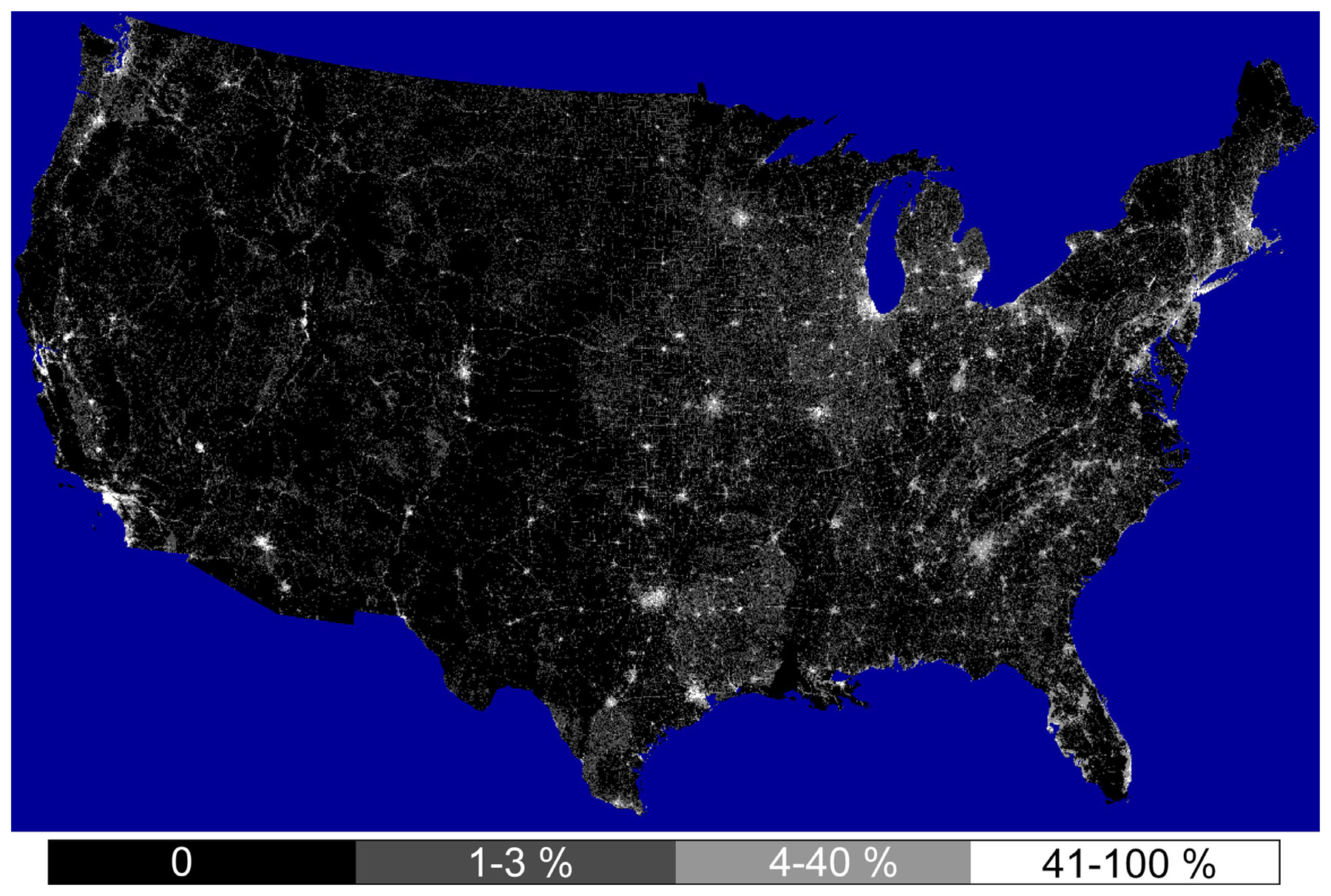
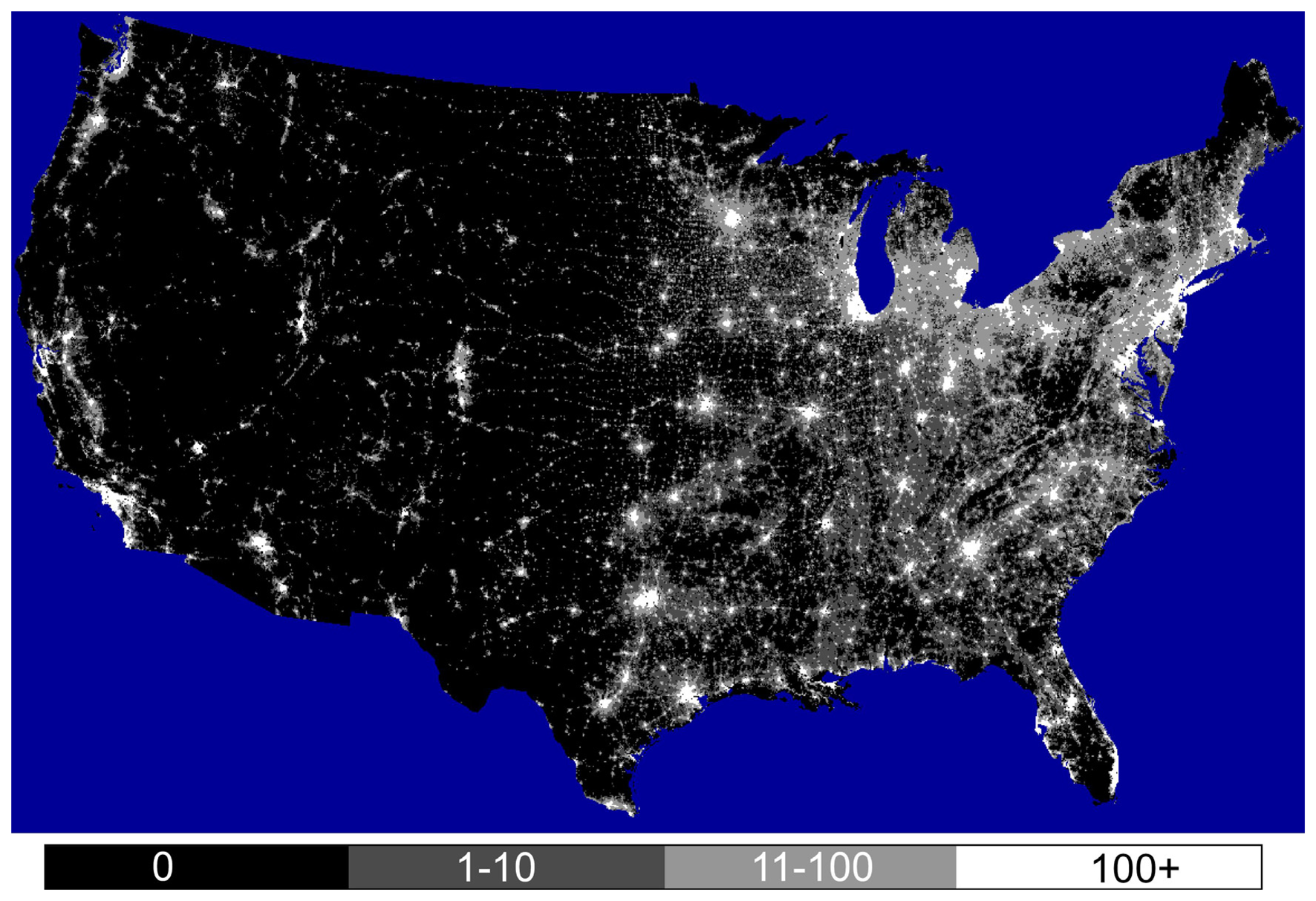
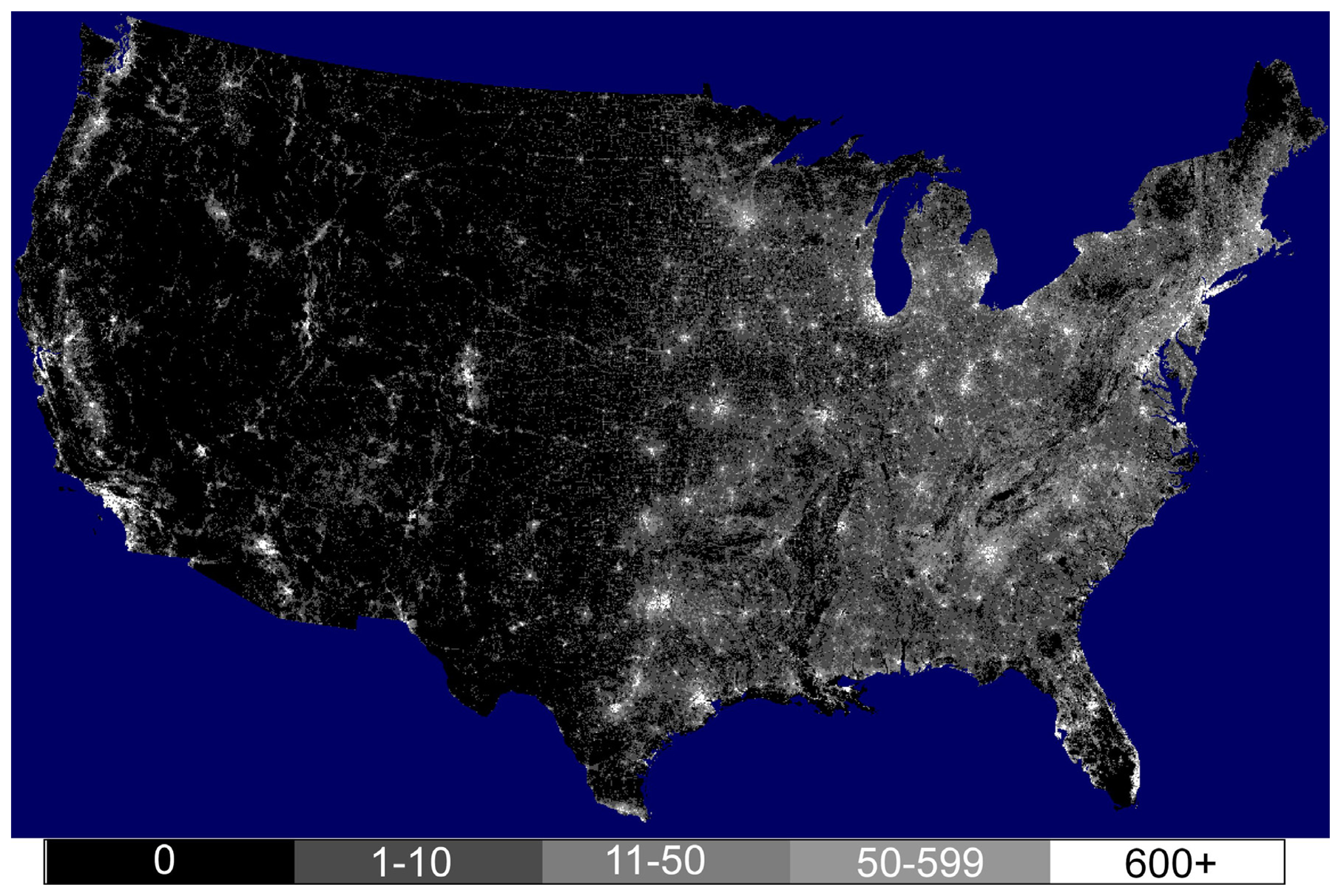
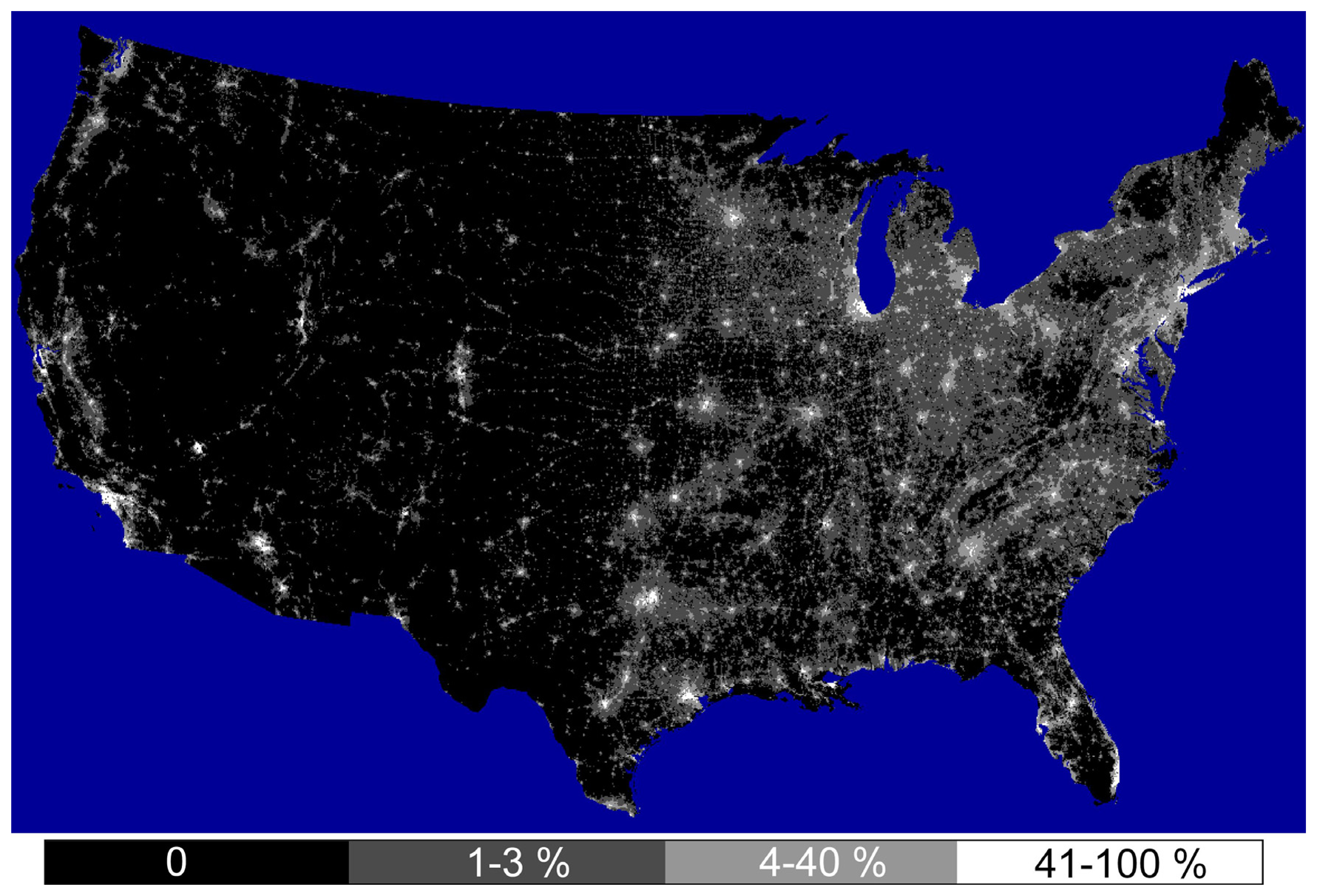
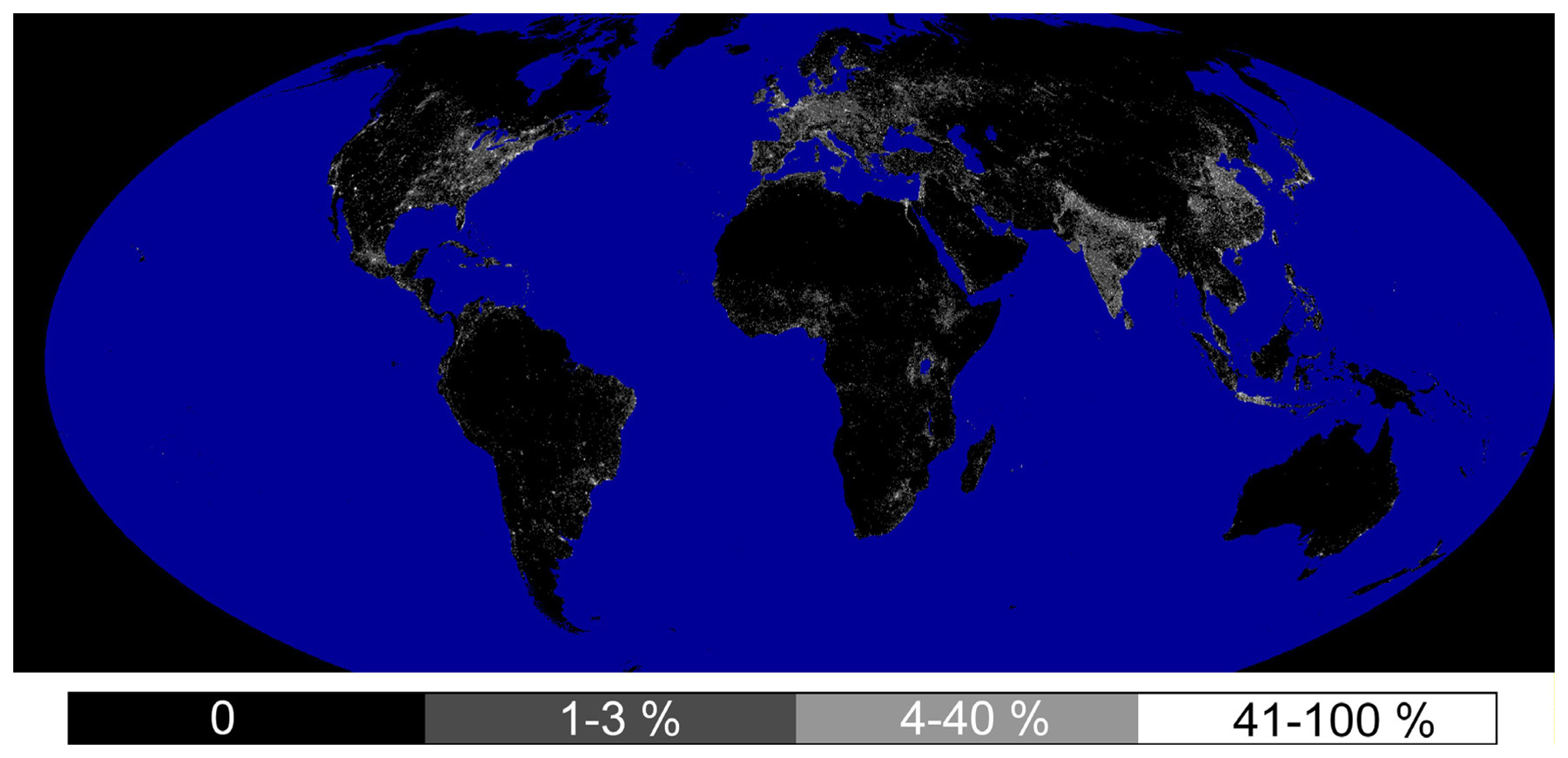
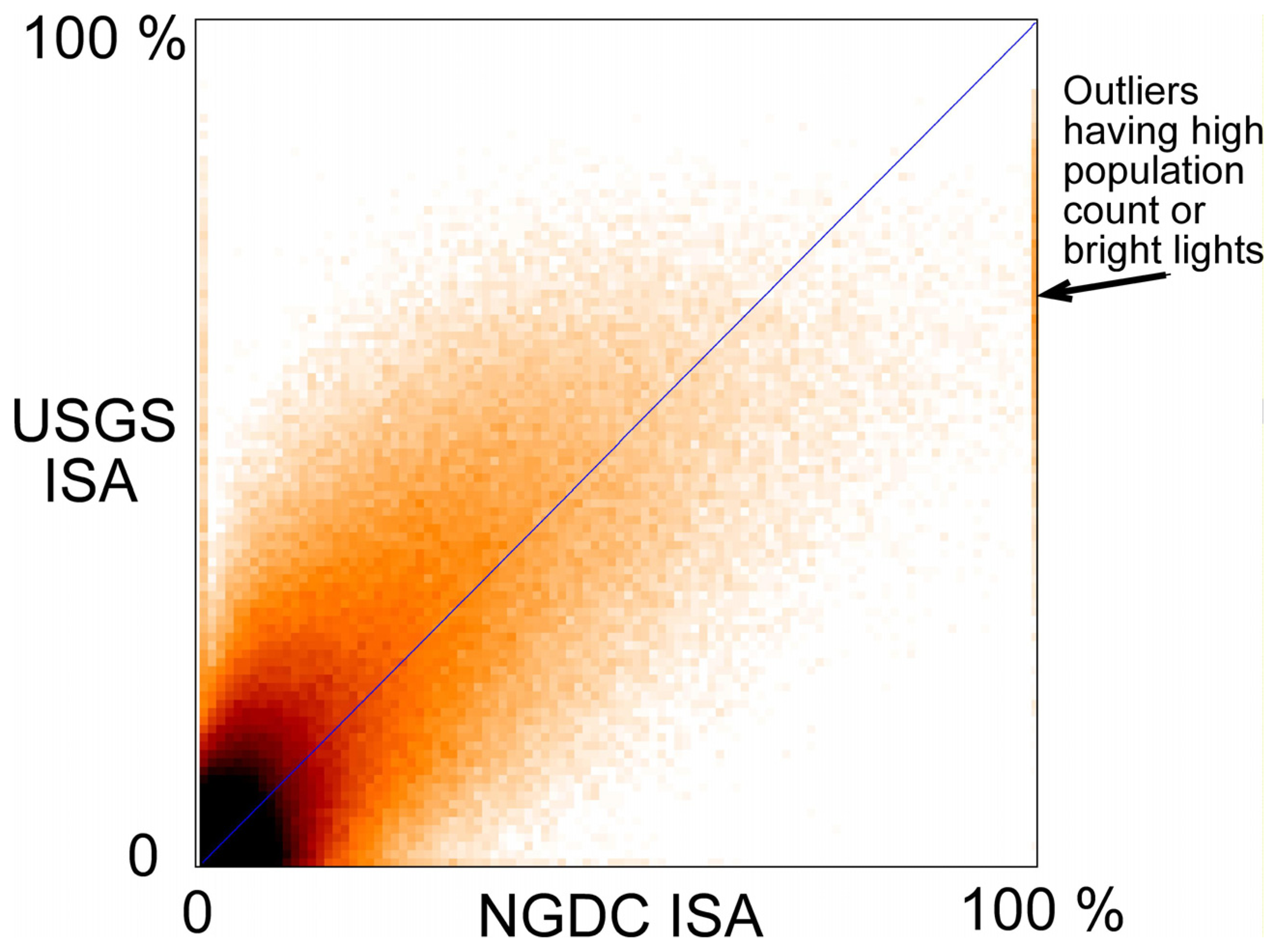
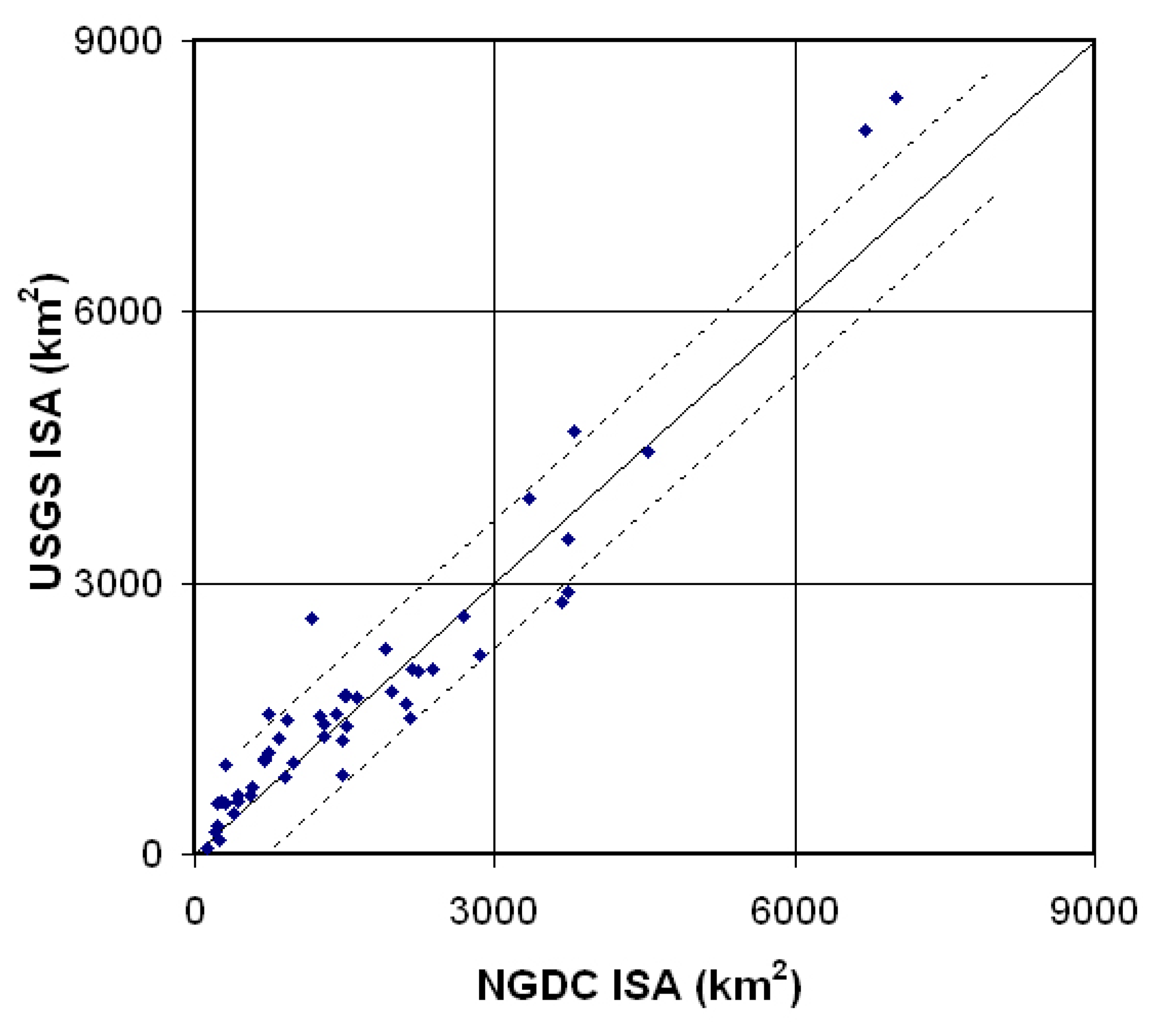
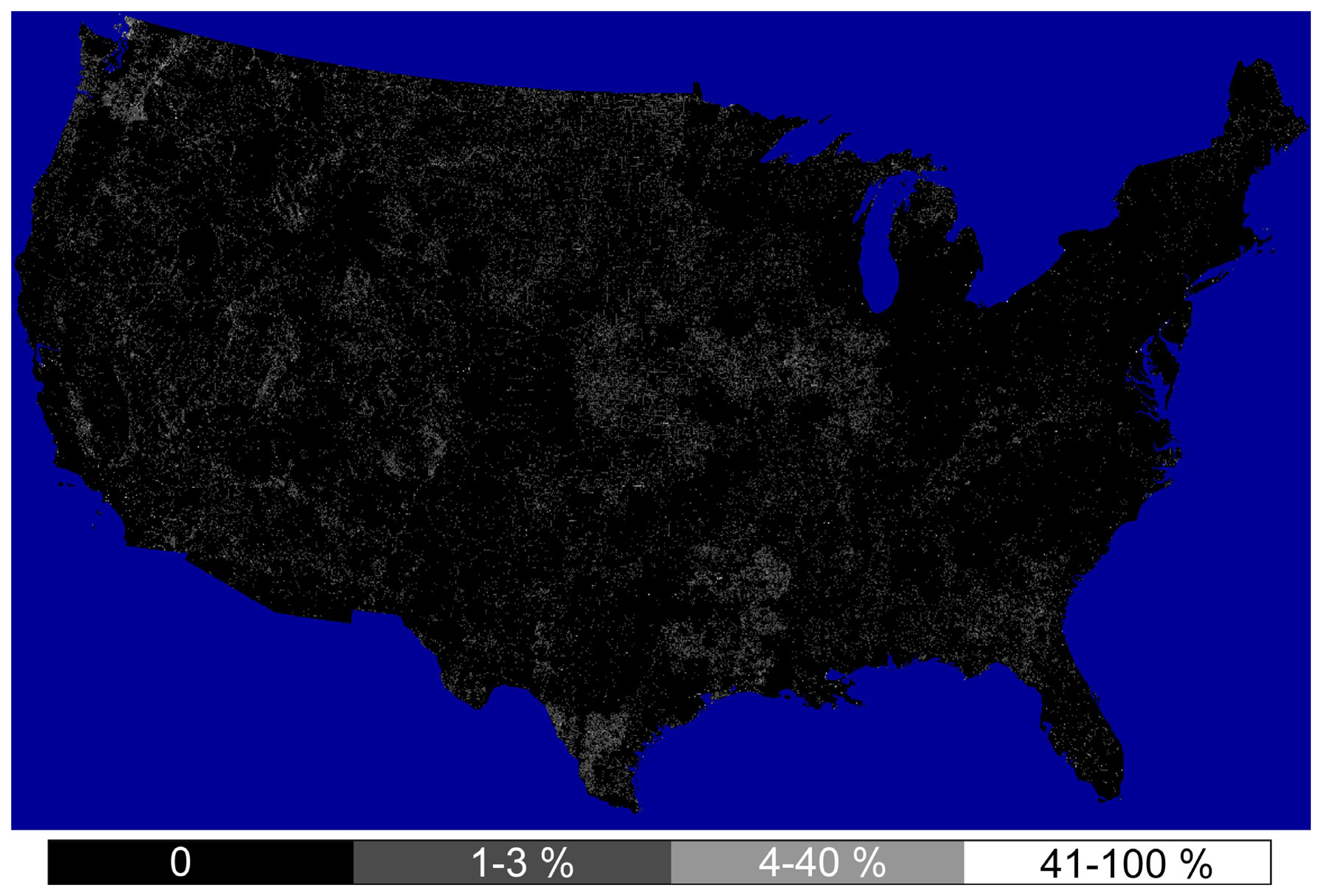


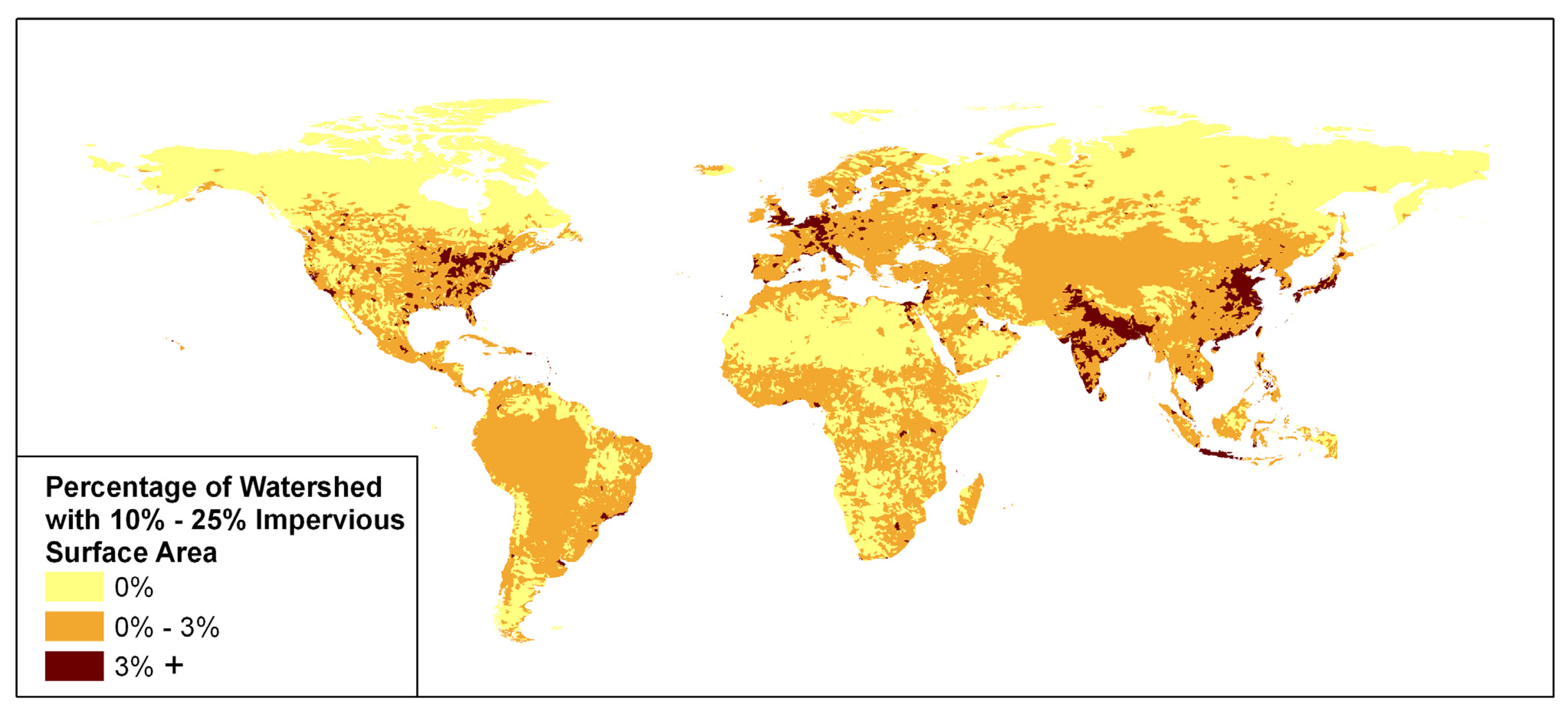


| COUNTRY | ISA km2 | Population (Landscan 2004) | ISA per Person (m2) |
|---|---|---|---|
| China | 87,182 | 1,292,548,864 | 67.4 |
| United States | 83,881 | 282,575,328 | 296.8 |
| India | 81,221 | 1,058,349,824 | 76.7 |
| Brazil | 17,766 | 177,885,936 | 99.9 |
| Russia | 17,135 | 138,947,840 | 123.3 |
| Indonesia | 16,490 | 230,000,208 | 71.7 |
| Japan | 13,990 | 122,192,928 | 114.5 |
| Mexico | 11,854 | 103,608,488 | 114.4 |
| Canada | 11,295 | 32,022,750 | 352.7 |
| Pakistan | 10,666 | 150,465,168 | 70.9 |
| France | 9,537 | 59,497,124 | 160.3 |
| Bangladesh | 8,878 | 140,275,504 | 63.3 |
| Germany | 8,500 | 82,406,312 | 103.1 |
| Italy | 8,294 | 56,528,760 | 146.7 |
| Nigeria | 7,668 | 125,118,728 | 61.3 |
| United Kingdom | 7,576 | 58,926,004 | 128.6 |
| Spain | 7,037 | 39,481,976 | 178.2 |
| Iran | 6,949 | 66,604,152 | 104.3 |
| Vietnam | 5,981 | 81,249,416 | 73.6 |
| Egypt | 5,745 | 75,240,640 | 76.4 |
| Thailand | 5,556 | 64,418,264 | 86.2 |
| Philippines | 5,428 | 80,687,360 | 67.3 |
| Turkey | 4,988 | 66,874,440 | 74.6 |
| Argentina | 4,733 | 38,680,324 | 122.3 |
| South Africa | 4,710 | 46,119,880 | 102.1 |
| South Korea | 4,452 | 46,192,628 | 96.4 |
| Ukraine | 4,262 | 47,400,144 | 89.9 |
| Poland | 4,242 | 38,523,048 | 110.1 |
| Ethiopia | 4,096 | 71,446,352 | 57.3 |
| Saudi Arabia | 4,057 | 25,289,332 | 160.4 |
| Colombia | 3,326 | 41,699,424 | 79.8 |
| Venezuela | 3,123 | 24,304,196 | 128.5 |
| Australia | 2,673 | 19,312,536 | 138.4 |
| Congo, DRC | 2,666 | 57,836,040 | 46.1 |
| Myanmar | 2,577 | 42,012,896 | 61.3 |
| Algeria | 2,489 | 31,531,672 | 79.0 |
| Malaysia | 2,344 | 22,441,990 | 104.5 |
| Uzbekistan | 2,219 | 26,386,720 | 84.1 |
| Romania | 2,146 | 22,365,804 | 96.0 |
| Kenya | 2,091 | 32,995,516 | 63.4 |
| Netherlands | 1,985 | 16,115,017 | 123.2 |
| Sweden | 1,893 | 8,698,591 | 217.6 |
| Morocco | 1,862 | 31,171,148 | 59.7 |
| Sudan | 1,824 | 40,477,688 | 45.1 |
| Iraq | 1,785 | 25,398,480 | 70.3 |
| Nepal | 1,750 | 27,308,324 | 64.1 |
| Uganda | 1,738 | 26,512,924 | 65.6 |
| Tanzania | 1,707 | 35,691,664 | 47.8 |
| Belgium | 1,670 | 10,370,094 | 161.0 |
| Finland | 1,647 | 5,104,438 | 322.7 |
| Portugal | 1,647 | 10,294,616 | 159.9 |
| Peru | 1,582 | 27,266,494 | 58.0 |
| Sri Lanka | 1,547 | 19,600,378 | 78.9 |
| Greece | 1,543 | 10,090,290 | 153.0 |
| Syria | 1,538 | 17,789,538 | 86.4 |
| Czech Republic | 1,439 | 10,232,928 | 140.7 |
| Chile | 1,428 | 15,293,033 | 93.4 |
| Ghana | 1,373 | 20,753,768 | 66.2 |
| Yemen | 1,343 | 19,757,588 | 68.0 |
| Afghanistan | 1,334 | 28,403,620 | 47.0 |
| Hungary | 1,262 | 10,033,943 | 125.8 |
| Kazakhstan | 1,153 | 15,185,784 | 75.9 |
| Guatemala | 1,136 | 14,271,432 | 79.6 |
| Ecuador | 1,132 | 12,774,985 | 88.6 |
| Austria | 1,096 | 8,136,709 | 134.7 |
| Israel | 1,067 | 5,981,165 | 178.3 |
| Serbia & Montenegro | 1,066 | 10,795,336 | 98.8 |
| North Korea | 1,047 | 22,079,722 | 47.4 |
| Tunisia | 996 | 9,637,170 | 103.3 |
| Cote d'Ivory | 995 | 16,300,517 | 61.0 |
| Norway | 985 | 4,193,063 | 234.9 |
| United Arab Emirates | 891 | 2,346,994 | 379.7 |
| Madagascar | 865 | 17,362,132 | 49.8 |
| Switzerland | 862 | 7,488,580 | 115.1 |
| Cambodia | 857 | 13,373,515 | 64.1 |
| Cuba | 851 | 11,147,445 | 76.4 |
| Malawi | 809 | 11,916,622 | 67.9 |
| Belarus | 805 | 10,320,822 | 78.0 |
| Bulgaria | 793 | 7,457,232 | 106.3 |
| Cameroon | 765 | 15,955,608 | 47.9 |
| Libya | 727 | 5,565,879 | 130.6 |
| Slovakia | 726 | 5,443,080 | 133.4 |
| Mozambique | 705 | 18,906,650 | 37.3 |
| Burkina Faso | 682 | 13,547,507 | 50.3 |
| Zimbabwe | 679 | 12,654,464 | 53.7 |
| Dominican Republic | 671 | 8,696,206 | 77.2 |
| Puerto Rico | 661 | 3,773,716 | 175.2 |
| Ireland | 626 | 3,835,449 | 163.3 |
| Bolivia | 618 | 8,744,160 | 70.7 |
| Azerbaijan | 587 | 7,868,001 | 74.6 |
| Denmark | 586 | 5,150,440 | 113.8 |
| Rwanda | 580 | 8,249,077 | 70.3 |
| Croatia | 572 | 4,317,700 | 132.5 |
| Senegal | 564 | 10,813,660 | 52.2 |
| El Salvador | 554 | 6,548,425 | 84.5 |
| Paraguay | 532 | 6,183,984 | 86.1 |
| Honduras | 515 | 6,695,838 | 76.9 |
| Jordan | 514 | 5,590,674 | 91.9 |
| Tajikistan | 498 | 7,009,976 | 71.1 |
| Zambia | 495 | 11,123,909 | 44.5 |
| TOTAL Worldwide | 579,703 | 6,245,732,591 | 93 |
© 2007 by MDPI ( http://www.mdpi.org). Reproduction is permitted for noncommercial purposes.
Share and Cite
Elvidge, C.D.; Tuttle, B.T.; Sutton, P.C.; Baugh, K.E.; Howard, A.T.; Milesi, C.; Bhaduri, B.; Nemani, R. Global Distribution and Density of Constructed Impervious Surfaces. Sensors 2007, 7, 1962-1979. https://doi.org/10.3390/s7091962
Elvidge CD, Tuttle BT, Sutton PC, Baugh KE, Howard AT, Milesi C, Bhaduri B, Nemani R. Global Distribution and Density of Constructed Impervious Surfaces. Sensors. 2007; 7(9):1962-1979. https://doi.org/10.3390/s7091962
Chicago/Turabian StyleElvidge, Christopher D., Benjamin T. Tuttle, Paul C. Sutton, Kimberly E. Baugh, Ara T. Howard, Cristina Milesi, Budhendra Bhaduri, and Ramakrishna Nemani. 2007. "Global Distribution and Density of Constructed Impervious Surfaces" Sensors 7, no. 9: 1962-1979. https://doi.org/10.3390/s7091962





